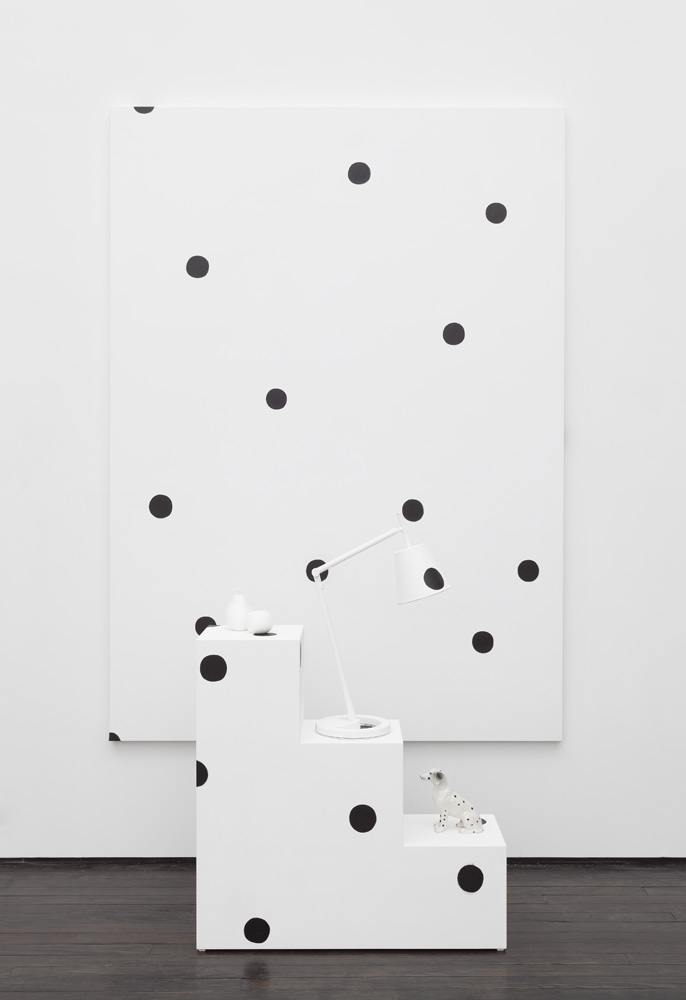Margaret Lee

ABOVE: MARGARET LEE’S DOTS (DALMATIAN), 2013. OIL, ACRYLIC, LINEN, WOOD, FOUND OBJECTS, AND PLASTER PAINTING. COURTESY OF THE ARTIST AND JACK HANLEY GALLERY. PHOTO: JOERG LOHSE.
According to artist Margaret Lee, there is a scene in David Lynch’s 1990 film Wild at Heart that perfectly sums up her creative enterprise: Nicolas Cage’s character, Sailor, says to his love interest, played by Laura Dern, “Did I ever tell you that this here jacket represents a symbol of my individuality and my belief in personal freedom?” The joke is, of course, on Sailor: everyone feels that their own leather jacket expresses their lone-wolf individuality. In her sculptural works, the 34-year-old, Bronx-born Lee encapsulates that anxious cultural transition when a symbol of radical, authentic identity becomes co-opted by the mainstream and yet is still perceived with all sincerity as an emblem of personal style. Lee, who also co-runs the influential Lower East Side gallery 47 Canal with her boyfriend, Oliver Newton, might be best known for her disturbingly lifelike plaster-cast sculptures of fruits and vegetables. A tangerine, a watermelon, a cucumber, an eggplant—these realistic, hand-painted, sexually charged forms are often displayed lounging on furniture, such as a cowhide Le Corbusier chair. The casts serve, all at once, as traditional still-life subjects, quirky showroom decor, and, best of all, ideological conversation pieces when considering Lee’s pendulum swing between extreme personalization and fashionable conformity. The individual gesture is obscenely present: the meticulous painting to affect the genuine skin of fruit is perhaps the most overt example of the artist’s hand, but, as it’s made from a cast, so is the reproducible, facsimile quality.
Recently, Lee’s interest in loaded objects has moved on to that favorite of interior-design elements: the pattern—in particular, the polka dot. “The gesture is so beautiful in almost a Zen way,” Lee explains. “It’s the perfect circle. For me, painting the circles in repetition, it’s like I finally found my artistic gesture.” The black-dot pattern works both as natural camouflage—Lee’s interest in dalmatians was a key instigator—and as an antic, hyper-stylized, artificial pop motif. It also happened to come into play after a recent visit to Barneys creative director Dennis Freedman’s house to see his 20th century furniture collection, where Lee fixated on the work by the late ’60s Italian artist collective Superstudio. “I’m very interested in systems that fail,” she says. “You can take the radicalism of the ’60s and ’70s, like the mission of Superstudio, and somehow transfer their productions into a new condo complex with the full Design Within Reach aesthetic. I see myself as this cannibal or savage that makes her way into the perfect environment through the backdoor and ends up subverting the home, where people feel most safe. And I kept coming back to Superstudio and their grid, the banality of the grid, and how it so perfectly fits into the reigning style of minimalism today. That grid was, for me, very much like the dots.”
This month, Lee opens her second solo show at New York’s Jack Hanley Gallery. Hilariously entitled “I don’t know if this is what they meant”—which is a response, in some ways, to the idea that good taste means everything should match—the exhibition consists of a showroom setup of a lamp, fruit, tables, chairs, shelves, and even a ceramic dalmatian, all patterned in black polka dots like a shrine to radical design resisting consumption or a store model display inviting it (or both). “I’m fascinated by this mentality of how consumption will save you,” Lee says. “It’s this new religion that everything will be better if you just buy as much as you can. It’s a quest for completion. And I believe it’s a real passion.” Lee’s fascination with consumption in the name of self-fulfillment may have its roots in biography. As a first-generation American with two parents who emigrated from Korea, the artist sees that inclination toward materiality as a vital cultural camouflage. “I think for a lot of immigrants, consumption is the only thing that helps you to assimilate,” Lee says. “There was this furniture warehouse near my house growing up. There was the lacquer section, the leopard section, the colonial section. I remember going there with my parents and finding comfort.”






